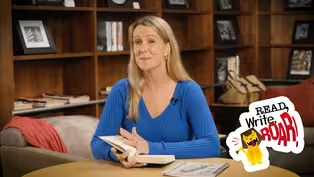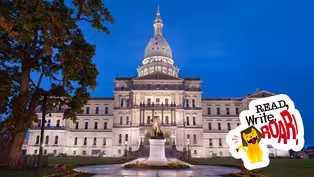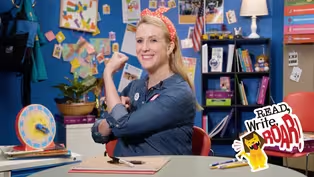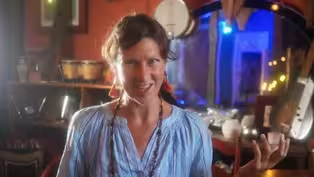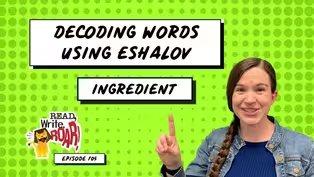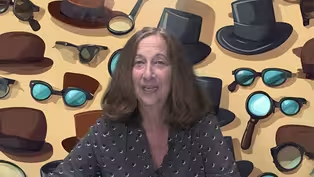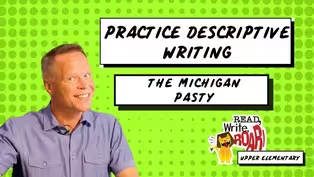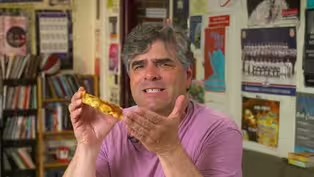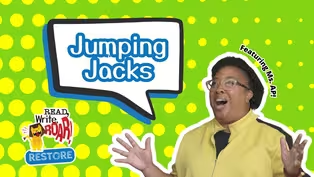Read, Write, ROAR!
Tasty Michigan Treats - Michigan's Unique Foods and Snacks
Season 1 Episode 1004 | 26m 45sVideo has Closed Captions
Learn about Michigan's magical foods!
Learn all about Michigan's tasty pasty and how it fueled miners in the Upper Peninsula. Then, an ode to Detroit's cheesy, crispy pizza.
Problems playing video? | Closed Captioning Feedback
Problems playing video? | Closed Captioning Feedback
Read, Write, ROAR! is a local public television program presented by Detroit PBS
Read, Write, ROAR!
Tasty Michigan Treats - Michigan's Unique Foods and Snacks
Season 1 Episode 1004 | 26m 45sVideo has Closed Captions
Learn all about Michigan's tasty pasty and how it fueled miners in the Upper Peninsula. Then, an ode to Detroit's cheesy, crispy pizza.
Problems playing video? | Closed Captioning Feedback
How to Watch Read, Write, ROAR!
Read, Write, ROAR! is available to stream on pbs.org and the free PBS App, available on iPhone, Apple TV, Android TV, Android smartphones, Amazon Fire TV, Amazon Fire Tablet, Roku, Samsung Smart TV, and Vizio.
Providing Support for PBS.org
Learn Moreabout PBS online sponsorshipMore from This Collection
Learn the literacy skills every 4th and 5th grader needs while exploring what makes Michigan unique.
Let's Talk Together - Michigan's Languages
Video has Closed Captions
Learn all about languages you might hear in Michigan! (26m 46s)
What's Up With the Weather? - Michigan's Climate
Video has Closed Captions
Learn all about Michigan's climate. (26m 46s)
Making Michigan - Lessons in Michigan History
Video has Closed Captions
Take a dive into the history of Michigan. (26m 45s)
Video has Closed Captions
Learn how to use multiple sources and how narrative text works! (26m 46s)
Providing Support for PBS.org
Learn Moreabout PBS online sponsorship- On Read, Write, ROAR!
Learn all about Michigan's tasty pasty, and how it fueled miners in the upper peninsula.
Then an ode to Detroit's cheesy crispy pizza.
Let's go.
Read, Write, ROAR!
- [Narrator] This program is made possible in part by, the state of Michigan, and by, (upbeat music) and by viewers like you.
Thank you.
(upbeat music) - Oh hey, it's me, Mr. Peterson.
I'm just here on my lunch break.
I brought a pasty.
Do you know about the pasty?
Some people mispronounce it as pasty.
The pasty is a meat pie.
They're very popular in northern Michigan.
You know, I wonder why that is.
Let's find out together and do some lunchtime learning.
Let's get that pesky pronunciation out of the way.
To help pronounce it correctly, it rhymes with the word nasty, pasty.
Once you taste it, that will definitely not be the word you use to describe it.
As we explore the history of this delicious treat, we'll be creating a timeline of important events.
Timelines help us as readers and writers, keep track of the order or sequence in which events happen.
It is believed the first pasty was made in Cornwall county, England, around the 1300s.
Cornwall was known for their mining of tin.
The miners that went into the ground, needed food that was self-contained, self insulated, and was packed with calories to provide energy, as the miners would sometimes be in the mines for over 12 hours.
The pasty looked like a hand sized pie that was stuffed with meat and potatoes, rutabagas and onions.
Shortly after Michigan became a state in 1837, it was discovered that the upper peninsula was rich in minerals and miners were needed.
So in 1840, miners from Cornwall, England, immigrated or came to Michigan to help develop the mines.
Along with the miners came one of their favorite foods, the pasty.
When word got out that the mines were rich in copper, immigrants from Finland and Italy started to arrive in the upper peninsula of Michigan around the 1880s.
These new immigrants learned to make the pasties from the Cornish miners, which helped them gain in popularity.
After the Mackinac Bridge was completed in 1957, it opened up the upper peninsula to tourism.
And the pasty went from a cooked at home favorite to a menu favorite at restaurants.
It became so popular, that the governor of Michigan in 1968 declared May 24th, Michigan pasty day.
Today, pasties are still enjoyed, and there are numerous festivals in honor of this historic meat pie.
Now that we learn the history of pasties, we could use the timeline about it to write a sequence paragraph, but you know what?
I would find it a shame not to take advantage of this delicious moment to change gears and write a descriptive paragraph.
So I decided to write a descriptive paragraph from the point of view of a minor in a copper mine, in the UP, from 1875.
When you write a descriptive paragraph, you use sensory images and details.
Sensory images describe your senses.
How do things look?
What do you hear?
How do things feel?
And how do they smell and taste?
I'm also writing from somebody else's point of view, a miner from the late 1800s.
So I need to think about how their senses might be different from mine, and how their life experiences were different from my own.
Okay, let's take a listen to my descriptive writing.
While I'm reading, pay attention to the descriptive language and the sensory images it creates.
Here we go.
- I hear someone shout, "lunch!"
And the word echoes off the damp dark walls of the mine.
At last, it's lunchtime.
My stomach's rumbling loudly, eager for the meal ahead.
Using the sleeve of my thick denim jacket, I clean the reddish brown dust from the copper ore we mine here off my shovel.
Then I lean the shovel against the mine's wall.
The lamp on my helmet casts a cozy dim glow, essential for seeing in the dark mine.
I carefully remove this lamp and place it on the ground.
Next, I position the blade of my shovel, just above the small flame of the lamp.
With hands stiff and grimy from the morning's work, I reach under my jacket to find a small cloth bundle I stashed there earlier.
Unwrapping it carefully, touching only the thick outer crust.
I reveal my lunch, a pasty!
I set the pasty on the shovel, letting it warm slightly over the lamp's gentle heat.
The pasty feels warm to the touch, like a stone sitting in the sun.
Holding it by the thick crust, I take a big bite from center.
The crispy shell breaks, releasing a burst of peppery gravy, and I savor the mix of beef, potatoes, and a hint of sweet onions.
Each bite is a delicious blend of flavors, making me forget the mine's chill for a moment.
As I enjoy my meal, the warmth of the food spreads through me, easing the aches in my muscles.
When I finish, I stand.
I re-attach the lamp to my helmet, grab my shovel, and prepare to continue working.
In six more hours, I'll climb out of this mine and head home, already dreaming of tomorrow's pasty.
- What do you think?
Could you imagine what it was like being a miner, eating a pasty for lunch?
Could you feel what it was like to be down in the dark mine and eating a tasty pasty, that you were warming over your headlamp?
Descriptive writing is fun.
It gives us a chance to be creative.
Next time you're eating lunch, maybe you can make it a learning lunch.
Imagine what words you could use to describe what the food in your lunch tastes like.
(upbeat music) (energetic music) (logo slaps) - I'm Ms. AP, here to help restore your energy.
Let's start with our warm up.
We are gonna be running in place by the count of 10.
Ready?
Go.
1, 2, 3, 4, 5, 6, 7, 8, 9, 10.
Good job everyone.
Now that we have warmed up our bodies, we are ready to exercise.
Today we are focusing on moving our arms to get ready.
I would like you to use your ready position.
Standing tall, arms at your side, feet together.
Once your body is in that ready position, you're gonna lift your arms out, up, and touch hands together above your head.
Let's try that a little bit faster.
Arms out, up, touch, down back at your side.
One more time.
Arms out, up, touch, arms down at your side.
All right, let's try 20 together.
1, 2, 3, 4, 5, 6.
(energetic music) Louder.
(energetic music) 15, 16, 17, 18, 19, 20.
Great job!
Give yourselves a big clap clap.
(Ms. AP claps) Wow!
Nice job.
Let's start cool down.
Breathe in and breathe out.
Breathe in and breathe out.
Great job.
(upbeat music) - Do you ever find complicated words when you're reading?
I know I do.
I'm Mrs. Mora.
Today we'll learn to use vowels and word parts to read and understand multi-syllabic words.
Michigan has amazing traditional foods, like the Michigan pasty.
As you explore new foods, you may come across complicated words.
The ESHALOV strategy helps us read long words.
ESHALOV means, Every Syllable Has At Least One Vowel.
This is almost always true.
Since a syllable can only have one vowel sound, vowels help us break words into parts.
Here's our word.
First, we'll mark all of the vowels.
Which vowels do you see?
Here's I, E, I, and E. Next, we'll join any vowel teams into one vowel sound.
A vowel team is a group of letters that work together to make one sound.
Do you see a vowel team?
I,E, may be a vowel team that says E or even I.
Sometimes I and E make separate vowel sounds, but let's join them for now.
Now, let's identify known word parts.
What do you see?
Here's the prefix, IN.
IN often means, in or into.
Let's count the number of word parts to expect.
Remember, almost every syllable has at least one vowel.
So, we'll count the vowel sounds to see how many parts to expect.
A vowel team counts as one part.
Let's count.
1, 2, 3.
Three parts.
Next we'll break the word into parts.
Since we counted three vowel sounds, we need three parts.
IN is a part because it has one vowel sound.
A syllable can only have one vowel sound, so we'll separate the E and the IE.
The D could join the second or the third syllable.
Let's try moving the D, into this third syllable.
Let's say the word, In, gre, dient, in gre dient.
Is that a real word?
Not quite.
When we first pronounce a word, we might need to try different letter sounds to make a real word.
Let's try the I sound instead of E. In, gre, dient.
Ingredient.
That's still not right.
Hmm.
Let's separate I and E. Now we have four parts, each with a vowel sound.
In, gre, d, ent.
Ingredient.
In this word, the I says E and the E makes the schwa sound, eh.
In, gre, di, ent.
Ingredient.
When we talk about food, an ingredient is something we add or mix into what we are preparing.
If you speak Spanish, the word ingrediente, can help you understand this word.
Great work today.
Keep reading and try the strategy the next time you find a challenging word.
(upbeat music) - Don't hate, appreciate.
How do you show appreciation for your favorite people or things?
Today I'm gonna show you a form of poetry that helps us express love.
Hi everybody, I'm Jeff Kass.
And we're gonna focus on an ancient poetry form called an ode.
An ode is a poem where we give a shout-out to something we love.
And when I say shout out, I mean shout-out!
I mean, pour a gargantuan triple milkshake sized salad bowl of love over whatever you're writing about.
I mean, stand on top of a mountain and shout towards the sky.
And do not be embarrassed.
Do not be shy.
Do not be, just a little bit in love.
Be a whole giant tanker ship in love.
Be in love like Serena Williams loves her tennis racket, like Spider-Man loves his web shooters, likes frogs love to (princess smooches) be kissed by princesses.
Okay, forget about that last part.
We don't really know if frogs love to be kissed.
I mean, have you ever kissed one?
I haven't.
Now, back to ode.
When you write an ode, you wanna talk directly to the object you're affections.
Use that pronoun you, as if you're talking straight to it.
Poets often do this by using the word, oh.
That's why we're writing an ode for example, to my hood of sweatshirt, I might begin by saying, "Oh, sweatshirt, that hugs me close."
Simple enough.
Another tip for writing an ode, use the five senses.
The poet and writer Maya Angelou said, "People will what you said, people will forget what you did, but people will never forget how you made them feel."
The five senses make us feel.
If we want our reader to connect with our writing and feel it, then we gotta use those senses.
Let's see if we can activate 'em here.
What if I say, "Oh sweatshirt, that hugs me close and smells like the laundry room where I folded my family's clothes when I was a teenager.
How you warm me when the breeze shoots its frozen needles toward my skin."
Now I'm engaged in the senses of touch and smell.
For connecting not just to the reader's brain, but to their body.
By the way, when you write an ode, you really want to kick the language up a notch.
Really exaggerate your descriptions.
A fancy term for that is hyperbole.
I love my hoodie 'cause it's comfy and always smells like lavender.
But instead of just saying when it's cold, I exaggerated a bit to help the reader really experience my hoodie, describing how it protects me from frozen needles.
You know something else I love, Detroit style pizza.
(upbeat music) Detroit style pizza originated in the 1940s.
Thanks to Gus Guerra and his wife Anna.
They ran a restaurant called Buddy's Rendezvous.
The original square shaped pizzas were baked in blue steel pans that Gus and Anna got from local automotive suppliers.
The pans, which were used as drip trays or to hold scrap metal in auto factories, were perfect for making the twice stretched pizza dough.
And since we're talking about delicious Michigan cuisine, let's write an ode to Detroit style pizza.
Let's start by exploring what we actually love about it.
It's square shaped.
The crust is thick and crispy on the outside.
Light and airy on the inside.
Slices are easy to pick up and won't flop and drip sauce and grease onto your hands or the front of your shirt.
Plus that gooey combination of Wisconsin brick cheese, crunchy crust, a porous chewy inside, tart tomato sauce.
It all explodes in your mouth like a fireworks of flavors.
Now, let's relate our list to the five senses and write an ode to Detroit style pizza.
And we'll mix some hyperbole in here too.
Okay, here's my attempt, "Oh, Detroit style pizza, how I cherish your thick square brick, how I can hold you in my hands without your goo dripping onto my shoes.
How my teeth feel the satisfying crunch of your crispy crust, every edge and adventure, like the skateboard of my taste buds flying through jump after jump.
Oh, Detroit style pizza, once my teeth pass the glorious gateway of your tongue tingling plunge, it is then I encounter the true nature of what it means to be cheese, emanating from the cheese-head state of Wisconsin.
Milky, creamy, velvety, Oh, Detroit style pizza, let us be BFF for eternity, oh, inside so light and airy, what a sweet surprise.
Like the city itself, all clank, grunt, and assembly line roar.
Oh, Rasheed Wallace trash talking, Joe Lewis' swinging fist, an octopus soaring onto the ice, all heart and love.
Revolutionary spirit of Rosa Parks and Marvin Gaye, a city verse everybody, a city with a love so big, it's got a pizza style all its own."
Did you notice in that ode, I said cheese emanating from the cheese-head state of Wisconsin.
Milky, creamy, velvety.
What do you think emanating means?
(upbeat music) Yeah, coming out of you.
You nailed it.
Lemme see what this tastes like that.
(crust crunches) (Mr. Kass moans) That is delicious.
(upbeat music) Now, it's your turn.
Write your own ode to Detroit style pizza or any other local food that you love really.
Remember, an ode is a poem that celebrates a person, place, or even a thing like pizza.
Fulfill your ode with lots of love.
Use the five senses along with descriptive language, and exaggerate.
Aim for at least 15 lines.
Have fun.
(upbeat music) - Hello friends, I'm Ms. Audra, and today we're going to the beach.
So, think about all the sounds you might hear at the beach, the waves crashing on shore, children playing, bit of sand, like kind of crunching under your feet, the sound of a seagull.
All kinds of different sounds you might hear at the beach.
So while we think about that, we're gonna take our breaths together.
Big inhale, (gentle music) (Ms. Audra inhales) we are gonna hold and then make the sound of the shore.
(whooshes) (gentle music) Push it all out.
And a breath in, (inhales) and hold.
(gentle music) Make the sound of the shore.
(Ms. Audra whooshing) (gentle music) Nice.
So think about all those sounds right, the waves crashing, the seagulls, people having fun, people laughing, walking together, playing or splashing, all the different sounds that you might hear, even music in the background.
So on the count of three, we're gonna all make our sound.
And don't forget to make a movement with your arm or your hand.
And if you have the space, use your whole body, right?
You could be playing volleyball, whatever it is for you.
And on the count of three, let's do it together.
Here we go.
1, 2, 3.
(gentle music) Keep it going, keep it going.
See if you can hear what other people are, sounding like and looking like.
and I'll make my own sound.
(Ms. Audra whooshing) All right, on the count of three, we're gonna pause.
1, 2, 3.
(Ms. Audra gasps) Nice.
Wow, it was so wonderful to create a soundscape together, of playing and having fun at the beach.
So, let's say goodbye as we always do with one breath in.
Here we go.
(inhales) And hold, blow it out any way you want to do.
(Ms. Audra whooshing) Alright, see you next time.
(upbeat music) - Hey scholars, when we are reading, especially non-fiction texts, we need to be detectives looking for clues to tell us if what we are reading is true.
Something that is true can also be a fact.
What is a fact?
A fact is a statement that can be proven to be true with evidence.
Facts do not tell us what someone thinks.
That is called an opinion.
When someone makes claims or statements using only their opinion, that is called bias.
Let's look at a topic that you might not be familiar with.
Voting ballots.
Dearborn, Michigan, has been called the capital of Arab America, and more than half of the population speaks a language other than English in their home.
Hamtramck, is another city with a large Arabic speaking population.
The title of the article, why Arabic ballots are now being offered in Michigan, and what this means for voter access in the US, is supported by these reasons.
The article tells us why voting ballots are now offered in the Arabic language in Michigan.
Today, we are going to check this article for facts by looking for claims.
A claim is a statement which needs evidence to prove it's a fact.
Here is an example of a claim from the article.
Dearborn is a suburb of Detroit, which is Michigan's most populated city.
Most populated means it has the most people living in it.
Where can we fact check to prove Detroit is Michigan's most populated city?
I started my fact checking on the internet, using known reliable sources, like government agencies and the Associated press.
According to the United States Census Bureau and the 2023 census, the city of Detroit and the Associated Press, Detroit is the most populated city in Michigan, with a population of 633,218.
The census is a count of all the people living in an area.
So, we have a claim and three different reliable sources that state the same evidence.
We can safely say, Detroit is in fact Michigan's most populated city.
Here's another claim made in the article.
There has been a substantial or big push in recent decades to create a new census category for people of Middle Eastern and North African descent.
In part to be better able to collect data and provide services for this demographic, I did some research and found out it's true.
The White House even announced this new category would be added.
Our claim evidence chart has evidence for three reliable sources, which all say that having a new category for people of Middle Eastern and North African descent, will be beneficial.
Wow, we've learned a lot about fact checking today, including how to find evidence and how to determine a fact from an opinion.
Let's review these terms in our game on the next screen.
Can you identify the fact checking types with the examples?
(upbeat music) If you guessed, opinion, evidence, and fact, you are right.
Now that you know how to look for evidence and you know the difference between a fact and an opinion, you will be an excellent news fact checker.
- Thank you for watching.
For more episodes, videos, lessons, activity guides, and more, be sure to visit us at our website.
And don't forget, Read, Write, ROAR!
(upbeat music) - [Narrator] This program is made possible in part by the state of Michigan, and by, (upbeat music) and by viewers like you.
Thank you.
(upbeat music) (upbeat music continues) (gentle music)
Beach Soundscape | Create Fun Sounds with Ms. Audra
Video has Closed Captions
Clip: S1 Ep1004 | 2m 15s | Create a beach soundscape using your voice and movements. (2m 15s)
Video has Closed Captions
Clip: S1 Ep1004 | 4m 18s | Use vowels to break words into parts. (4m 18s)
Fact vs. Opinion: How to Be a News Detective
Video has Closed Captions
Clip: S1 Ep1004 | 4m 7s | Fact-check claims using reliable sources. (4m 7s)
Video has Closed Captions
Clip: S1 Ep1004 | 6m 39s | Model descriptive writing with a paragraph from an 1800s miner's perspective. (6m 39s)
Ode to Detroit Style Pizza: Celebrating What You Love in Poetry
Video has Closed Captions
Clip: S1 Ep1004 | 6m | Write an "ode," a poem that gives a big shout-out to something we love. (6m)
Read, Write, ROAR! Restore - Jumping Jacks
Video has Closed Captions
Clip: S1 Ep1004 | 2m 28s | A 2-minute workout combining arm and leg movements in a jumping jack routine. (2m 28s)
Providing Support for PBS.org
Learn Moreabout PBS online sponsorship

- Home and How To

Hit the road in a classic car for a tour through Great Britain with two antiques experts.












Support for PBS provided by:
Read, Write, ROAR! is a local public television program presented by Detroit PBS
